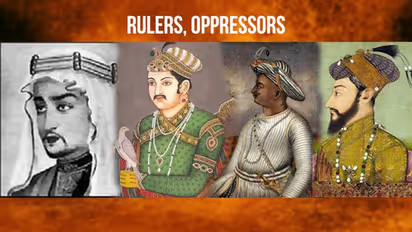
True Indology has again exposed the Left's attempt to distort Indian history and peddle falsehood.
It was claimed by IndiaExplained that every Muslim ruler in India since Mohammed bin Qasim had Hindus in bureaucracy and military, and had alliances with Hindu rulers, which proves that the Hindus were never oppressed by Muslim rulers.
This sparked off a Twitter war and True Indology challenged IndiaExplained to name even a single Hindu in Mohammed bin Qasim's bureaucracy, political or military authorities. It was rightly pointed out that even if there were a sizeable number of people from a particular community in the bureaucracy and military of a ruler, it did not necessarily mean that people from that community were not persecuted.
Also read — Tipu Jayanti: Who says the Sultan was not a bigot?
Hitler had 1,50,000 Jews in his army, but that doesn't mean that the holocaust never happened, True Indology pointed out. Nazi dictator Hitler had had six million (60 lakh) Jews exterminated from 1941-45 when the Second World War was underway. Hitler was notorious for his anti-Semitism, blaming the Jews to have been responsible for Germany's surrender in the First World War.
Similarly, despite Hindus being part of the administration and armies of various Muslim rulers, the oppression that Hindus, and non-Muslims in general faced can't be denied.
Mohammed bin Qasim reigned during a time (712-715 AD) that was just after the rise of Islam. So IndiaExplained has included almost all Muslim rulers that have ever reigned in India to have been tolerant towards Hindus. However, the truth is whether it was the Mamluks, Tughlaqs, Lodhis, Khaljis, Sayyids, Afghans, Mughals or provincial rulers like Tipu Sultan, all Muslim rulers had tried to treat Hindus with an iron fist.
Mughal emperor Akbar was believed to have been the most tolerant of the Muslim rulers, who got into matrimonial alliances with Hindu kings, introduced a new, accomodative religion called din-i-ilahi and had Hindus in high offices, including Birbal and Todar Mal, who were part of the Navratnas. In fact, Akbar has been given the monicker, 'Akbar the Great', but he had Hindu blood on his hands too.
Also read — True Indology Live: Amarnath Yatra much older than Muslim shepherd myth
The initial years of Akbar's reign saw the massacre of the Hindus of Garha in 1560. The rulers of Chittor and Ranthambore were also targeted.
In addition to the persecution and ransacking of temples and destruction of idols was the crippling jizya tax on the Hindus.
Invaders like Mahmud of Ghazni, Mohammad Ghori and Timur had targeted the Hindu population and its temples. Mahmud attacked and ransacked the Somnath temple, completely denuding it of its riches, and destroyed the famous Shiva lingam inside it. The Somnath temple was repeatedly demolished by successive Muslim invaders. The Ghaznavi army plundered and destroyed temples across the Gangetic plains. Mahmud's court historian Al-Utbi viewed it as a jihad to propagate Islam and stamp out idolatry.
FS Growse, in his book, Mathura-Brindaban: The Mystical Land of Lord Krishna, says about Mahmud's Mathura campaign, "Orders were given that all the temples should be burnt with naphthala and fire and levelled with the ground. The city was given up to plunder for twenty days. Among the spoil are said to have been five great idols of pure gold with eyes of rubies and adornments of other precious stones, together with a vast number of smaller silver images, which, when broken up, formed a load for more than a hundred camels."
Mohammad Ghori attacked Varanasi at the end of the 12th century, and continued to destroy Hindu idols and temples, which he started to do since his first raid in 1194.
Violence on the ground of religion continued under Jalaluddin Firoz Shah Khalji and the notorious Alauddin Khalji. The military commanders Ulugh Khan, Nusrat Khan, Khusro Khan and Malik Kafur wreaked havoc, killing, looting and enslaving non-Mulsims. The Khalji court historian wrote, "...all the burnt Hindus would be despatched by the sword to their brothers in hell, so that fire, the improper object of their worship, might mete out proper punishment to them."
In 1193, Bakhtiyar Khalji destroyed the Nalanda University complex and Buddhist and Hindu libraries and manuscripts at Nalanda and Odantapuri universities.
Oppression of the Hindus became unbearable under Aurangzeb. He reintroduced the jizya tax on non-Muslims, led campaigns that attacked non-Muslims, destroyed temples and forcibly converted Hindus to Islam. the construction of new temples was also banned.
Tipu Sultan, often celebrated for the stout resistance he offered to the British, is known to have persecuted Hindus and Christians and carried out forced conversions of Hindus and Christians. According to some accounts, he ordered the destruction of temples in Kerala.
So the Muslim rulers have always been governed by the aim of expanding Islam even if it meant ruthless subjugation of the native population, and employed both physical violence and economic sanctions as part of their policy. Often having alliances with Hindu kings and having Hindus in administration and army were strategic necessities. To say that it showed the Muslim rulers were tolerant towards the Hindus (and other non-Muslims) and never oppressed them is pure bunkum.